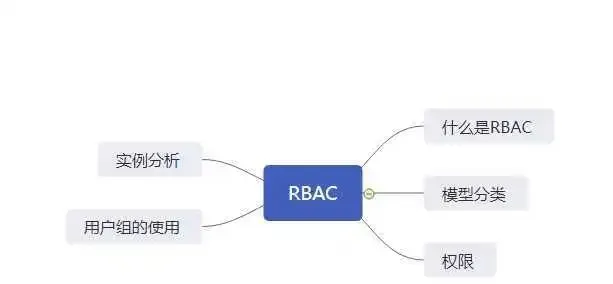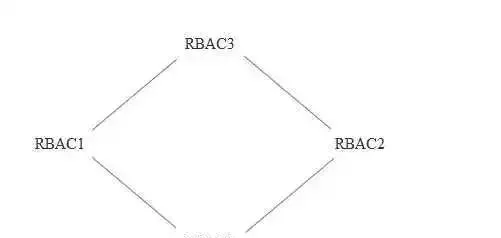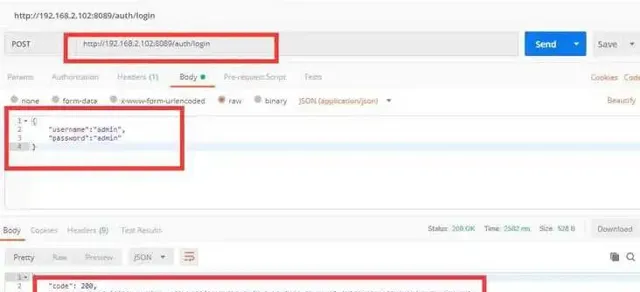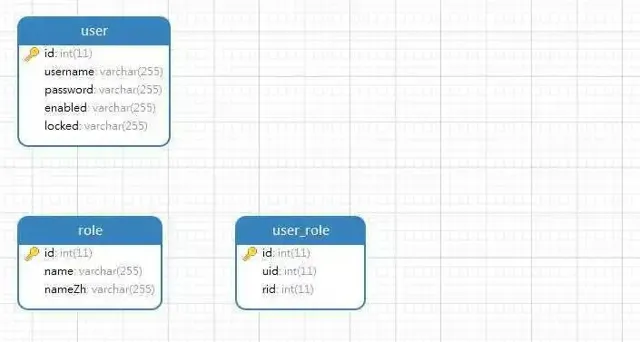RBAC許可權分析
RBAC 全稱為基於角色的許可權控制,本文將會從什麽是RBAC,模型分類,什麽是許可權,使用者組的使用,例項分析等幾個方面闡述RBAC
思維導圖

什麽是RBAC
例項分析等幾個方面闡述RBAC
RBAC 全稱為使用者角色許可權控制,透過角色關聯使用者,角色關聯許可權,這種方式,間階的賦予使用者的許可權,如下圖所示
對於通常的系統而言,存在多個使用者具有相同的許可權,在分配的時候,要為指定的使用者分配相關的許可權,修改的時候也要依次的對這幾個使用者的許可權進行修改,有了角色這個許可權,在修改許可權的時候,只需要對角色進行修改,就可以實作相關的許可權的修改。這樣做增加了效率,減少了許可權漏洞的發生。
模型分類
對於RBAC模型來說,分為以下幾個模型 分別是RBAC0,RBAC1,RBAC2,RBAC3,這四個模型,這段將會依次介紹這四個模型,其中最常用的模型有RBAC0.
RBAC0
RBAC0是最簡單的RBAC模型,這裏麵包含了兩種。
使用者和角色是多對一的關系 ,即一個使用者只充當一種角色,一個角色可以有多個角色的擔當。
使用者和角色是多對多的關系 ,即,一個使用者可以同時充當多個角色,一個角色可以有多個使用者。
此系統功能單一,人員較少,這裏舉個栗子,張三既是行政,也負責財務,此時張三就有倆個許可權,分別是行政許可權,和財務許可權兩個部份。
RBAC1
相對於RBAC0模型來說,增加了子角色,引入了繼承的概念。

RBAC2 模型
這裏RBAC2模型,在RBAC0模型的基礎上,增加了一些功能,以及限制
角色互斥
即,同一個使用者不能擁有兩個互斥的角色,舉個例子,在財務系統中,一個使用者不能擁有會計員和審計這兩種角色。
基數約束
即,用一個角色,所擁有的成員是固定的,例如對於CEO這種角色,同一個角色,也只能有一個使用者。
先決條件
即,對於該角色來說,如果想要獲得更高的角色,需要先獲取低一級別的角色。舉個栗子,對於副總經理和經理這兩個許可權來說,需要先有副總經理許可權,才能擁有經理許可權,其中副總經理許可權是經理許可權的先決條件。
執行時互斥
即,一個使用者可以擁有兩個角色,但是這倆個角色不能同時使用,需要切換角色才能進入另外一個角色。舉個栗子,對於總經理和專員這兩個角色,系統只能在一段時間,擁有其一個角色,不能同時對這兩種角色進行操作。
RBAC3模型
即,RBAC1,RBAC2,兩者模型全部累計,稱為統一模型。

什麽是許可權
許可權是資源的集合,這裏的資源指的是軟體中的所有的內容,即,對頁面的操作許可權,對頁面的存取許可權,對數據的增刪查改的許可權。舉個栗子。對於下圖中的系統而言,

擁有,計劃管理,客戶管理,合約管理,出入庫通知單管理,糧食安全追溯,糧食統計查詢,裝置管理這幾個頁面,對這幾個頁面的存取,以及是否能夠存取到選單,都屬於許可權。
使用者組的使用
對於使用者組來說,是把眾多的使用者劃分為一組,進行批次授予角色,即,批次授予許可權。
舉個栗子,對於部門來說,一個部門擁有一萬多個員工,這些員工都擁有相同的角色,如果沒有使用者組,可能需要一個個的授予相關的角色,在擁有了使用者組以後,只需要,把這些使用者全部劃分為一組,然後對該組設定授予角色,就等同於對這些使用者授予角色。
優點:減少工作量,便於理解,增加多級管理,等。
SpringSecurity 簡單使用
首先添加依賴
<dependency>
<groupId>org.springframework.boot</groupId>
<artifactId>spring-boot-starter-security</artifactId>
</dependency>
然後添加相關的存取介面
packagecom.example.demo.web;
importorg.springframework.web.bind.annotation.RequestMapping;
importorg.springframework.web.bind.annotation.RestController;
@RestController
@RequestMapping("/test")
public class Test {
@RequestMapping("/test")
public String test(){
return "test";
}
}
最後啟動計畫,在日誌中檢視相關的密碼
存取介面,可以看到相關的登入界面

輸入使用者名稱和相關的密碼
使用者名稱:user
密碼 984cccf2-ba82-468e-a404-7d32123d0f9c

增加使用者名稱和密碼
在配置檔中,書寫相關的登入和密碼
spring:
security:
user:
name: ming
password: 123456
roles: admin
在登入頁面,輸入使用者名稱和密碼,即可正常登入
基於記憶體的認證
需要自訂類繼承 WebSecurityConfigurerAdapter 程式碼如下
packagecom.example.demo.config;
importorg.springframework.context.annotation.Bean;
importorg.springframework.context.annotation.Configuration;
importorg.springframework.security.config.annotation.authentication.builders.AuthenticationManagerBuilder;
importorg.springframework.security.config.annotation.web.configuration.WebSecurityConfigurerAdapter;
importorg.springframework.security.crypto.password.NoOpPasswordEncoder;
importorg.springframework.security.crypto.password.PasswordEncoder;
@Configuration
public class MyWebSecurityConfig extends WebSecurityConfigurerAdapter {
@Bean
PasswordEncoder passwordEncoder(){
returnNoOpPasswordEncoder.getInstance();
}
@Override
protected void configure(AuthenticationManagerBuilder auth) throws Exception {
auth.inMemoryAuthentication()
.withUser("admin").password("123").roles("admin");
}
}
即,配置的使用者名稱為admin,密碼為123,角色為admin
HttpSecurity
這裏對一些方法進行攔截
package com.ming.demo.interceptor;
import org.springframework.beans.factory.annotation.Autowired;
import org.springframework.context.annotation.Bean;
import org.springframework.context.annotation.Configuration;
import org.springframework.http.HttpMethod;
import org.springframework.security.config.annotation.authentication.builders.AuthenticationManagerBuilder;
import org.springframework.security.config.annotation.method.configuration.EnableGlobalMethodSecurity;
import org.springframework.security.config.annotation.web.builders.HttpSecurity;
import org.springframework.security.config.annotation.web.configuration.EnableWebSecurity;
import org.springframework.security.config.annotation.web.configuration.WebSecurityConfigurerAdapter;
import org.springframework.security.crypto.bcrypt.BCryptPasswordEncoder;
import org.springframework.security.crypto.password.PasswordEncoder;
import org.springframework.security.web.authentication.rememberme.TokenBasedRememberMeServices;
@Configuration
@EnableWebSecurity
public classSecurityConfigextendsWebSecurityConfigurerAdapter{
//基於記憶體的使用者儲存
@Override
publicvoidconfigure(AuthenticationManagerBuilder auth)throws Exception {
auth.inMemoryAuthentication()
.withUser("itguang").password("123456").roles("USER").and()
.withUser("admin").password("{noop}" + "123456").roles("ADMIN");
}
//請求攔截
@Override
protectedvoidconfigure(HttpSecurity http)throws Exception {
http.authorizeRequests()
.anyRequest().permitAll()
.and()
.formLogin()
.permitAll()
.and()
.logout()
.permitAll();
}
}
即,這裏完成了對所有的方法存取的攔截。
SpringSecurity 整合JWT
這是一個小demo,目的,登入以後返回jwt生成的token
匯入依賴
添加web依賴

匯入JWT和Security依賴
<!-- https://mvnrepository.com/artifact/io.jsonwebtoken/jjwt -->
<dependency>
<groupId>io.jsonwebtoken</groupId>
<artifactId>jjwt</artifactId>
<version>0.9.1</version>
</dependency>
<!-- https://mvnrepository.com/artifact/org.springframework.boot/spring-boot-starter-security -->
<dependency>
<groupId>org.springframework.boot</groupId>
<artifactId>spring-boot-starter-security</artifactId>
<version>2.3.1.RELEASE</version>
</dependency>
建立一個JwtUser實作UserDetails
建立 一個相關的JavaBean
package com.example.demo;
import org.springframework.security.core.GrantedAuthority;
import org.springframework.security.core.userdetails.UserDetails;
import java.util.Collection;
public classJwtUserimplementsUserDetails{
private String username;
private String password;
private Integer state;
private Collection<? extends GrantedAuthority> authorities;
publicJwtUser(){
}
publicJwtUser(String username, String password, Integer state, Collection<? extends GrantedAuthority> authorities){
this.username = username;
this.password = password;
this.state = state;
this.authorities = authorities;
}
@Override
public Collection<? extends GrantedAuthority> getAuthorities() {
return authorities;
}
@Override
public String getPassword(){
returnthis.password;
}
@Override
public String getUsername(){
returnthis.username;
}
@Override
publicbooleanisAccountNonExpired(){
returntrue;
}
@Override
publicbooleanisAccountNonLocked(){
returntrue;
}
@Override
publicbooleanisCredentialsNonExpired(){
returntrue;
}
@Override
publicbooleanisEnabled(){
returntrue;
}
}
編寫工具類生成令牌
編寫工具類,用來生成token,以及重新整理token,以及驗證token
package com.example.demo;
import io.jsonwebtoken.Claims;
import io.jsonwebtoken.Jwts;
import io.jsonwebtoken.SignatureAlgorithm;
import org.springframework.security.core.userdetails.UserDetails;
import java.io.Serializable;
import java.util.Date;
import java.util.HashMap;
import java.util.Map;
public class JwtTokenUtil implements Serializable {
privateString secret;
private Long expiration;
privateString header;
privateString generateToken(Map<String, Object> claims) {
Date expirationDate = newDate(System.currentTimeMillis() + expiration);
return Jwts.builder().setClaims(claims).setExpiration(expirationDate).signWith(SignatureAlgorithm.HS512, secret).compact();
}
private Claims getClaimsFromToken(String token) {
Claims claims;
try {
claims = Jwts.parser().setSigningKey(secret).parseClaimsJws(token).getBody();
} catch (Exception e) {
claims = null;
}
return claims;
}
publicString generateToken(UserDetails userDetails) {
Map<String, Object> claims = new HashMap<>(2);
claims.put("sub", userDetails.getUsername());
claims.put("created", newDate());
return generateToken(claims);
}
publicString getUsernameFromToken(String token) {
String username;
try {
Claims claims = getClaimsFromToken(token);
username = claims.getSubject();
} catch (Exception e) {
username = null;
}
return username;
}
publicBoolean isTokenExpired(String token) {
try {
Claims claims = getClaimsFromToken(token);
Date expiration = claims.getExpiration();
return expiration.before(newDate());
} catch (Exception e) {
returnfalse;
}
}
publicString refreshToken(String token) {
String refreshedToken;
try {
Claims claims = getClaimsFromToken(token);
claims.put("created", newDate());
refreshedToken = generateToken(claims);
} catch (Exception e) {
refreshedToken = null;
}
return refreshedToken;
}
publicBoolean validateToken(String token, UserDetails userDetails) {
JwtUser user = (JwtUser) userDetails;
String username = getUsernameFromToken(token);
return (username.equals(user.getUsername()) && !isTokenExpired(token));
}
}
編寫攔截器
編寫Filter 用來檢測JWT
package com.example.demo;
import org.apache.commons.lang.StringUtils;
import org.springframework.beans.factory.annotation.Autowired;
import org.springframework.security.authentication.UsernamePasswordAuthenticationToken;
import org.springframework.security.core.context.SecurityContextHolder;
import org.springframework.security.core.userdetails.UserDetails;
import org.springframework.security.core.userdetails.UserDetailsService;
import org.springframework.security.web.authentication.WebAuthenticationDetailsSource;
import org.springframework.stereotype.Component;
import org.springframework.web.filter.OncePerRequestFilter;
import javax.servlet.FilterChain;
import javax.servlet.ServletException;
import javax.servlet.http.HttpServletRequest;
import javax.servlet.http.HttpServletResponse;
import java.io.IOException;
@Component
public classJwtAuthenticationTokenFilterextendsOncePerRequestFilter{
@Autowired
private UserDetailsService userDetailsService;
@Autowired
private JwtTokenUtil jwtTokenUtil;
@Override
protectedvoiddoFilterInternal(HttpServletRequest httpServletRequest, HttpServletResponse httpServletResponse, FilterChain filterChain)throws ServletException, IOException {
String authHeader = httpServletRequest.getHeader(jwtTokenUtil.getHeader());
if (authHeader != null && StringUtils.isNotEmpty(authHeader)) {
String username = jwtTokenUtil.getUsernameFromToken(authHeader);
if (username != null && SecurityContextHolder.getContext().getAuthentication() == null) {
UserDetails userDetails = this.userDetailsService.loadUserByUsername(username);
if (jwtTokenUtil.validateToken(authHeader, userDetails)) {
UsernamePasswordAuthenticationToken authentication =
new UsernamePasswordAuthenticationToken(userDetails,null,userDetails.getAuthorities());
authentication.setDetails(new WebAuthenticationDetailsSource().buildDetails(httpServletRequest));
SecurityContextHolder.getContext().setAuthentication(authentication);
}
}
}
filterChain.doFilter(httpServletRequest, httpServletResponse);
}
}
編寫userDetailsService的實作類
在上方程式碼中,編寫userDetailsService,類,實作其驗證過程
package com.example.demo;
import org.springframework.beans.factory.annotation.Autowired;
import org.springframework.security.core.authority.SimpleGrantedAuthority;
import org.springframework.security.core.userdetails.User;
import org.springframework.security.core.userdetails.UserDetails;
import org.springframework.security.core.userdetails.UserDetailsService;
import org.springframework.security.core.userdetails.UsernameNotFoundException;
import org.springframework.stereotype.Service;
import javax.management.relation.Role;
import java.util.List;
@Service
public classJwtUserDetailsServiceImplimplementsUserDetailsService{
@Autowired
private UserMapper userMapper;
@Override
public UserDetails loadUserByUsername(String s)throws UsernameNotFoundException {
User user = userMapper.selectByUserName(s);
if (user == null) {
thrownew UsernameNotFoundException(String.format("'%s'.這個使用者不存在", s));
}
List<SimpleGrantedAuthority> collect = user.getRoles().stream().map(Role::getRolename).map(SimpleGrantedAuthority::new).collect(Collectors.toList());
returnnew JwtUser(user.getUsername(), user.getPassword(), user.getState(), collect);
}
}
編寫登入
編寫登入業務的實作類 其login方法會返回一個JWTUtils 的token
@Service
public classUserServiceImplimplementsUserService{
@Autowired
private UserMapper userMapper;
@Autowired
private AuthenticationManager authenticationManager;
@Autowired
private UserDetailsService userDetailsService;
@Autowired
private JwtTokenUtil jwtTokenUtil;
public User findByUsername(String username){
User user = userMapper.selectByUserName(username);
return user;
}
public RetResult login(String username, String password)throws AuthenticationException {
UsernamePasswordAuthenticationToken upToken = new UsernamePasswordAuthenticationToken(username, password);
final Authentication authentication = authenticationManager.authenticate(upToken);
SecurityContextHolder.getContext().setAuthentication(authentication);
UserDetails userDetails = userDetailsService.loadUserByUsername(username);
returnnew RetResult(RetCode.SUCCESS.getCode(),jwtTokenUtil.generateToken(userDetails));
}
}
最後配置Config
@EnableGlobalMethodSecurity(prePostEnabled = true)
@EnableWebSecurity
public classWebSecurityextendsWebSecurityConfigurerAdapter{
@Autowired
private UserDetailsService userDetailsService;
@Autowired
private JwtAuthenticationTokenFilter jwtAuthenticationTokenFilter;
@Autowired
publicvoidconfigureAuthentication(AuthenticationManagerBuilder authenticationManagerBuilder)throws Exception {
authenticationManagerBuilder.userDetailsService(this.userDetailsService).passwordEncoder(passwordEncoder());
}
@Bean(name = BeanIds.AUTHENTICATION_MANAGER)
@Override
public AuthenticationManager authenticationManagerBean()throws Exception {
returnsuper.authenticationManagerBean();
}
@Bean
public PasswordEncoder passwordEncoder(){
returnnew BCryptPasswordEncoder();
}
@Override
protectedvoidconfigure(HttpSecurity http)throws Exception {
http.csrf().disable().sessionManagement().sessionCreationPolicy(SessionCreationPolicy.STATELESS)
.and().authorizeRequests()
.antMatchers(HttpMethod.OPTIONS, "/**").permitAll()
.antMatchers("/auth/**").permitAll()
.anyRequest().authenticated()
.and().headers().cacheControl();
http.addFilterBefore(jwtAuthenticationTokenFilter, UsernamePasswordAuthenticationFilter. class);
ExpressionUrlAuthorizationConfigurer<HttpSecurity>.ExpressionInterceptUrlRegistry registry = http.authorizeRequests();
registry.requestMatchers(CorsUtils::isPreFlightRequest).permitAll();
}
@Bean
public CorsFilter corsFilter(){
final UrlBasedCorsConfigurationSource urlBasedCorsConfigurationSource = new UrlBasedCorsConfigurationSource();
final CorsConfiguration cors = new CorsConfiguration();
cors.setAllowCredentials(true);
cors.addAllowedOrigin("*");
cors.addAllowedHeader("*");
cors.addAllowedMethod("*");
urlBasedCorsConfigurationSource.registerCorsConfiguration("/**", cors);
returnnew CorsFilter(urlBasedCorsConfigurationSource);
}
}
執行,返回token
執行,返回結果為token

SpringSecurity JSON登入
這裏配置SpringSecurity之JSON登入
這裏需要重寫UsernamePasswordAnthenticationFilter類,以及配置SpringSecurity
重寫UsernamePasswordAnthenticationFilter
public classCustomAuthenticationFilterextendsUsernamePasswordAuthenticationFilter{
@Override
public Authentication attemptAuthentication(HttpServletRequest request, HttpServletResponse response)throws AuthenticationException {
//attempt Authentication when Content-Type is json
if(request.getContentType().equals(MediaType.APPLICATION_JSON_UTF8_VALUE)
||request.getContentType().equals(MediaType.APPLICATION_JSON_VALUE)){
//use jackson to deserialize json
ObjectMapper mapper = new ObjectMapper();
UsernamePasswordAuthenticationToken authRequest = null;
try (InputStream is = request.getInputStream()){
AuthenticationBean authenticationBean = mapper.readValue(is,AuthenticationBean. class);
authRequest = new UsernamePasswordAuthenticationToken(
authenticationBean.getUsername(), authenticationBean.getPassword());
}catch (IOException e) {
e.printStackTrace();
authRequest = new UsernamePasswordAuthenticationToken(
"", "");
}finally {
setDetails(request, authRequest);
returnthis.getAuthenticationManager().authenticate(authRequest);
}
}
//transmit it to UsernamePasswordAuthenticationFilter
else {
returnsuper.attemptAuthentication(request, response);
}
}
}
配置SecurityConfig
@Override
protectedvoidconfigure(HttpSecurity http)throws Exception {
http
.cors().and()
.antMatcher("/**").authorizeRequests()
.antMatchers("/", "/login**").permitAll()
.anyRequest().authenticated()
//這裏必須要寫formLogin(),不然原有的UsernamePasswordAuthenticationFilter不會出現,也就無法配置我們重新的UsernamePasswordAuthenticationFilter
.and().formLogin().loginPage("/")
.and().csrf().disable();
//用重寫的Filter替換掉原有的UsernamePasswordAuthenticationFilter
http.addFilterAt(customAuthenticationFilter(),
UsernamePasswordAuthenticationFilter. class);
}
//註冊自訂的UsernamePasswordAuthenticationFilter
@Bean
CustomAuthenticationFilter customAuthenticationFilter()throws Exception {
CustomAuthenticationFilter filter = new CustomAuthenticationFilter();
filter.setAuthenticationSuccessHandler(new SuccessHandler());
filter.setAuthenticationFailureHandler(new FailureHandler());
filter.setFilterProcessesUrl("/login/self");
//這句很關鍵,重用WebSecurityConfigurerAdapter配置的AuthenticationManager,不然要自己組裝AuthenticationManager
filter.setAuthenticationManager(authenticationManagerBean());
return filter;
}
這樣就完成使用json登入SpringSecurity
Spring Security 密碼加密方式
需要在Config 類中配置如下內容
/**
* 密碼加密
*/
@Bean
public BCryptPasswordEncoder passwordEncoder(){
returnnew BCryptPasswordEncoder();
}
即,使用此方法,對密碼進行加密, 在業務層的時候,使用此加密的方法
@Service
@Transactional
public classUserServiceImplimplementsUserService{
@Resource
private UserRepository userRepository;
@Resource
private BCryptPasswordEncoder bCryptPasswordEncoder; //註入bcryct加密
@Override
public User add(User user){
user.setPassword(bCryptPasswordEncoder.encode(user.getPassword())); //對密碼進行加密
User user2 = userRepository.save(user);
return user2;
}
@Override
public ResultInfo login(User user){
ResultInfo resultInfo=new ResultInfo();
User user2 = userRepository.findByName(user.getName());
if (user2==null) {
resultInfo.setCode("-1");
resultInfo.setMessage("使用者名稱不存在");
return resultInfo;
}
//判斷密碼是否正確
if (!bCryptPasswordEncoder.matches(user.getPassword(),user2.getPassword())) {
resultInfo.setCode("-1");
resultInfo.setMessage("密碼不正確");
return resultInfo;
}
resultInfo.setMessage("登入成功");
return resultInfo;
}
}
即,使用BCryptPasswordEncoder 對密碼進行加密,保存資料庫
使用資料庫認證
這裏使用資料庫認證SpringSecurity
設計數據表
這裏設計數據表

著重配置SpringConfig
@Configurable
public classWebSecurityConfigextendsWebSecurityConfigurerAdapter{
@Autowired
private UserService userService; // service 層註入
@Bean
PasswordEncoder passwordEncoder(){
returnnew BCryptPasswordEncoder();
}
@Override
protectedvoidconfigure(AuthenticationManagerBuilder auth)throws Exception {
// 參數傳入Service,進行驗證
auth.userDetailsService(userService);
}
@Override
protectedvoidconfigure(HttpSecurity http)throws Exception {
http.authorizeRequests()
.antMatchers("/admin/**").hasRole("admin")
.anyRequest().authenticated()
.and()
.formLogin()
.loginProcessingUrl("/login").permitAll()
.and()
.csrf().disable();
}
}
這裏著重配置SpringConfig
小結
著重講解了RBAC的許可權配置,以及簡單的使用SpringSecurity,以及使用SpringSecurity + JWT 完成前後端的分離,以及配置json登入,和密碼加密方式。
如喜歡本文,請點選右上角,把文章分享到朋友圈
如有想了解學習的技術點,請留言給若飛安排分享
因公眾號更改推播規則,請點「在看」並加「星標」 第一時間獲取精彩技術分享
·END·
相關閱讀:
作者:小小____
來源:https://segmentfault.com/a/1190000023052493
版權申明:內容來源網路,僅供學習研究,版權歸原創者所有。如有侵權煩請告知,我們會立即刪除並表示歉意。謝謝!
架構師
我們都是架構師!
關註 架構師(JiaGouX),添加「星標」
獲取每天技術幹貨,一起成為牛逼架構師
技術群請 加若飛: 1321113940 進架構師群
投稿、合作、版權等信箱: [email protected]











